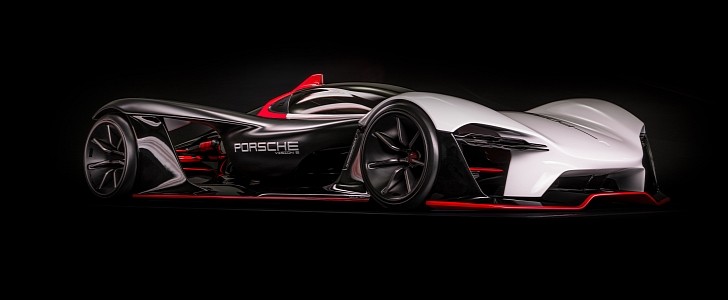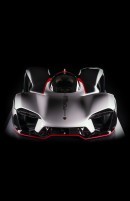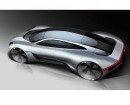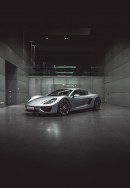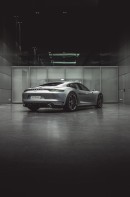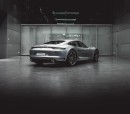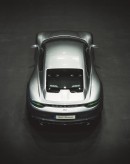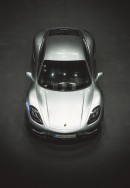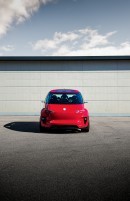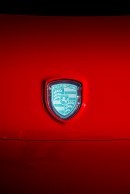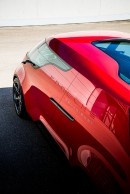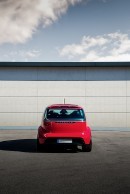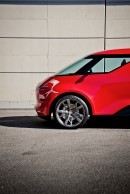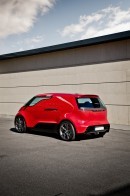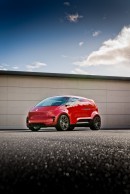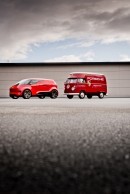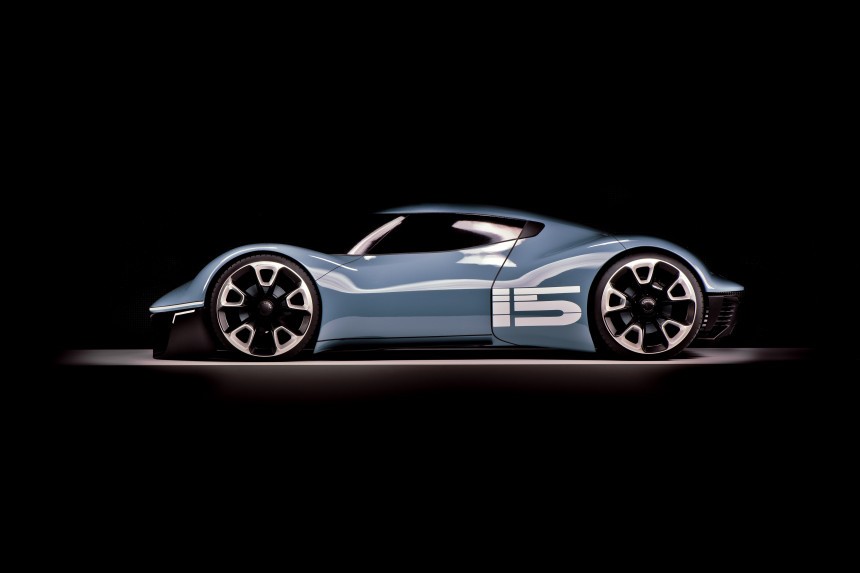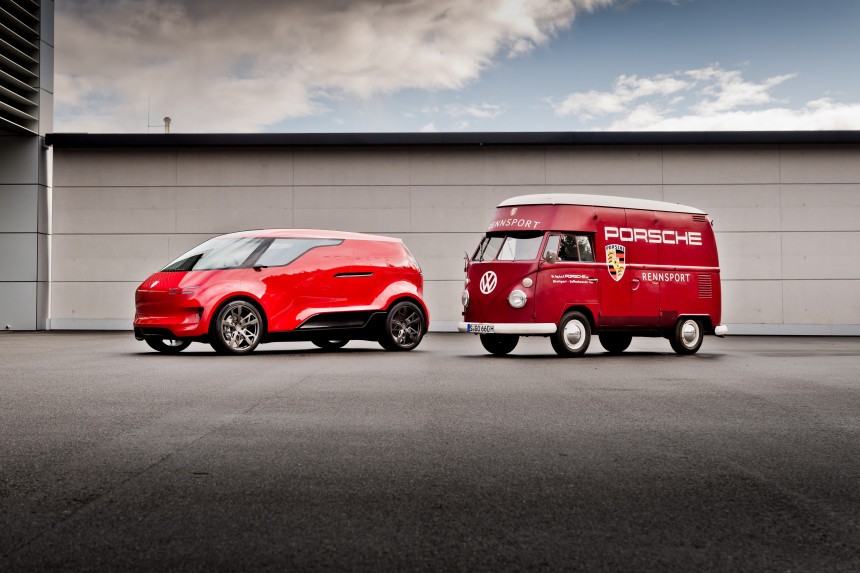Have you ever wondered what Porsche has been cooking behind the scenes of its electric car revolution? Sure, we've seen the Mission E concept and the Taycan that derived from it, but the German automaker has obviously prepared a small electric universe before sending such a machine into the showroom. And we can now check out four battery-powered studies the company had kept hidden.
You are now reading the second story of our three-article series dedicated to showcasing these new-to-the-world-outside-Porsche concepts, which were born between 2005 and 2019. Officially dubbed Porsche Unseen (you'll find the complete collection behind this link), the carmaker's initiative also allows us to zoom in on exotic production model derivatives (think: the long-rumored Porsche 911 Safari), as well as on a group of hypercars that might just see the Germans returning to Le Mans one day.
We'll kick off this electron juice tale with the Porsche Vision E (pictured above), which envisions nothing less than a customer racecar aimed to come "as close as possible to a modern Formula E racer,"
As many of you know, Porsche left Le Mans' top-tier LMP1 category after grabbing the third consecutive title (following the latest return) in 2017. And while the automaker had prepared an engine for Formula One, it entered Formula E instead, joining the all-electric competition for the 2019 season.
Completed last year, the Vision E, which is linked to the Porsche 99X Formula E racecar, wasn't a functional prototype, but a 1:1 scale hard model.
Formula E, whose inaugural season took place in 2014, has allowed teams to have more control over the creation of their cars with each new season, thus gradually introducing greater technical differentiation between the racecars. For instance, Porsche's 99X features a custom drivetrain, with the company stating this "could also serve as a basis for future all-electric sports cars for the race track and road [Vision E included],"
As such, the single-seater configuration of this track-only toy has been maintained, while we can talk about an 800V architecture. For the record, the Taycan also features such hardware. And, as opposed to the 400V system most production EVs currently use, this facilitates faster charging and reduces the influence the battery's state of charge has on performance.
While all these concepts were created under the supervision of Michael Mauer, who joined Porsche as Chief Designer back in 2004, the next proposal came from one of the company's design interns.
This "baby" electric sportscar is dubbed Vision 916, a name it borrows from the Porsche 916 prototype of the 1970s, which never made it to production - the pigeon-blue study we have here dates back to 2016 and comes in the form of a 1:1 scale clay model.
However, it previews a compact two-seater with stunning looks, which might one day fulfill the dream of an entry-level Porsche sportscar. We'll remind you the automaker was planning to build such a machine by sharing a platform with VW and Audi. However, while the scheme was previewed by the VW Bluesport concept of 2009, no production model was released, with the plan being officially put on the back burner in 2014.
Motivation for this electric pocket rocket comes from four wheel-hub motors. This, of course, is a tribute to the first all-wheel drive Lohner-Porsche race car, which the tech genius that was Ferdinand Porsche developed in 1900.
Fast-forward to 2019, the year when the Taycan was introduced, it's difficult not to regard this as the Panamera's non-identical twin. Nevertheless, as Michael Mauer explains, the story of how the carmaker's first production EV came to be is a bit different - it looks like the starting point for the Taycan was none other than the... 918 Spyder hypercar, whose design evolved into the Vision Turismo concept we have here (this is a 1:1 hard model developed in 2016).
"When walking past, I saw a schematic representation of the Porsche 918 on a designer's drawing board in our studio. A line had been redrawn with a felt-tip pen to clearly show the falling contour,” Porsche's design boss explains. “From the corner of my eye it looked like a rear door joint. I was astonished!”
Once the notion of a four-door velocity tool was on the table, the carmaker started experimenting with various ideas related to the layout, from maintaining the midship status to introducing a rear-engined setup, which would finally bring a factory take on a concept that had been in the minds of enthusiasts for half a century (keep in mind that Texas-based coachbuilder Troutman and Barnes built a four-door 911 back in the late 1960s).
However, with the German automaker also working on the idea of electric propulsion last decade, it was decided this would be the ideal solution for the future model.
Check out the posterior of the Porsche Vision Turismo and you'll notice what is the origin of the side-to-side rear light cluster that can now be found on the majority of the carmaker's models. And it seems that the front lighting signature of the concept sits at the core of the company's electric vehicle design identity.
A bit of a shocker, this Porsche Vision "Race Service" concept, isn't it? Heck, even the blue-dominated Porsche crest adorning its nose is different.
The idea behind the contraption, which was created in 2018 as a 1:1 hard model, was to deliver a great deal of cabin room.
Called Vision "Renndienst" in its home country, this van might not strike one as the typical Porsche, but it does have an ancestor in the brand's history, namely the VW race service van that used to provide assistance to motorsport teams back in the day.
Once you look past the exterior, which seems to mix a space shuttle with flared wheel arches normally found on a sportscar, you'll find an unusual interior layout, one that involves a central driving position.
With all the electric hardware sitting underneath the floor, the passengers can enjoy a spacious environment. And it's worth noting the one behind the wheel can also join them in various actives, providing that the autonomous driving features are engaged (remember, this is a concept).
And while this proposal might compensate for the limited surface of the side windows by using various cabin screens (this is our assumption), the Porsche hypercar studies we'll be discussing in our next story have the idea of a small greenhouse in their DNA.
We'll kick off this electron juice tale with the Porsche Vision E (pictured above), which envisions nothing less than a customer racecar aimed to come "as close as possible to a modern Formula E racer,"
As many of you know, Porsche left Le Mans' top-tier LMP1 category after grabbing the third consecutive title (following the latest return) in 2017. And while the automaker had prepared an engine for Formula One, it entered Formula E instead, joining the all-electric competition for the 2019 season.
Completed last year, the Vision E, which is linked to the Porsche 99X Formula E racecar, wasn't a functional prototype, but a 1:1 scale hard model.
Formula E, whose inaugural season took place in 2014, has allowed teams to have more control over the creation of their cars with each new season, thus gradually introducing greater technical differentiation between the racecars. For instance, Porsche's 99X features a custom drivetrain, with the company stating this "could also serve as a basis for future all-electric sports cars for the race track and road [Vision E included],"
As such, the single-seater configuration of this track-only toy has been maintained, while we can talk about an 800V architecture. For the record, the Taycan also features such hardware. And, as opposed to the 400V system most production EVs currently use, this facilitates faster charging and reduces the influence the battery's state of charge has on performance.
This "baby" electric sportscar is dubbed Vision 916, a name it borrows from the Porsche 916 prototype of the 1970s, which never made it to production - the pigeon-blue study we have here dates back to 2016 and comes in the form of a 1:1 scale clay model.
However, it previews a compact two-seater with stunning looks, which might one day fulfill the dream of an entry-level Porsche sportscar. We'll remind you the automaker was planning to build such a machine by sharing a platform with VW and Audi. However, while the scheme was previewed by the VW Bluesport concept of 2009, no production model was released, with the plan being officially put on the back burner in 2014.
Motivation for this electric pocket rocket comes from four wheel-hub motors. This, of course, is a tribute to the first all-wheel drive Lohner-Porsche race car, which the tech genius that was Ferdinand Porsche developed in 1900.
"When walking past, I saw a schematic representation of the Porsche 918 on a designer's drawing board in our studio. A line had been redrawn with a felt-tip pen to clearly show the falling contour,” Porsche's design boss explains. “From the corner of my eye it looked like a rear door joint. I was astonished!”
Once the notion of a four-door velocity tool was on the table, the carmaker started experimenting with various ideas related to the layout, from maintaining the midship status to introducing a rear-engined setup, which would finally bring a factory take on a concept that had been in the minds of enthusiasts for half a century (keep in mind that Texas-based coachbuilder Troutman and Barnes built a four-door 911 back in the late 1960s).
However, with the German automaker also working on the idea of electric propulsion last decade, it was decided this would be the ideal solution for the future model.
Check out the posterior of the Porsche Vision Turismo and you'll notice what is the origin of the side-to-side rear light cluster that can now be found on the majority of the carmaker's models. And it seems that the front lighting signature of the concept sits at the core of the company's electric vehicle design identity.
The idea behind the contraption, which was created in 2018 as a 1:1 hard model, was to deliver a great deal of cabin room.
Called Vision "Renndienst" in its home country, this van might not strike one as the typical Porsche, but it does have an ancestor in the brand's history, namely the VW race service van that used to provide assistance to motorsport teams back in the day.
Once you look past the exterior, which seems to mix a space shuttle with flared wheel arches normally found on a sportscar, you'll find an unusual interior layout, one that involves a central driving position.
With all the electric hardware sitting underneath the floor, the passengers can enjoy a spacious environment. And it's worth noting the one behind the wheel can also join them in various actives, providing that the autonomous driving features are engaged (remember, this is a concept).
And while this proposal might compensate for the limited surface of the side windows by using various cabin screens (this is our assumption), the Porsche hypercar studies we'll be discussing in our next story have the idea of a small greenhouse in their DNA.
